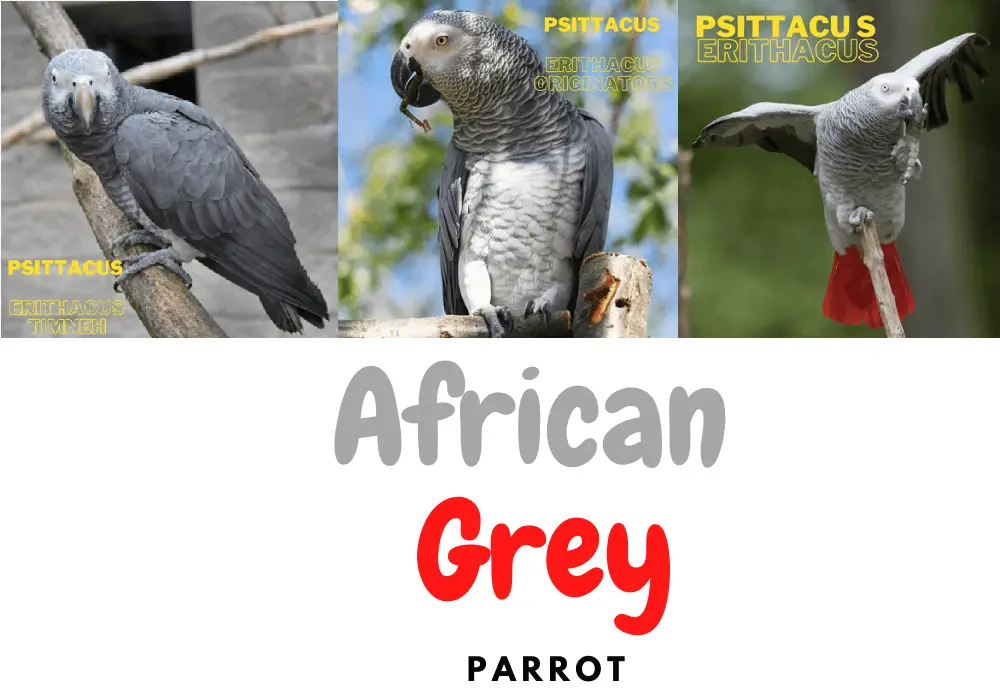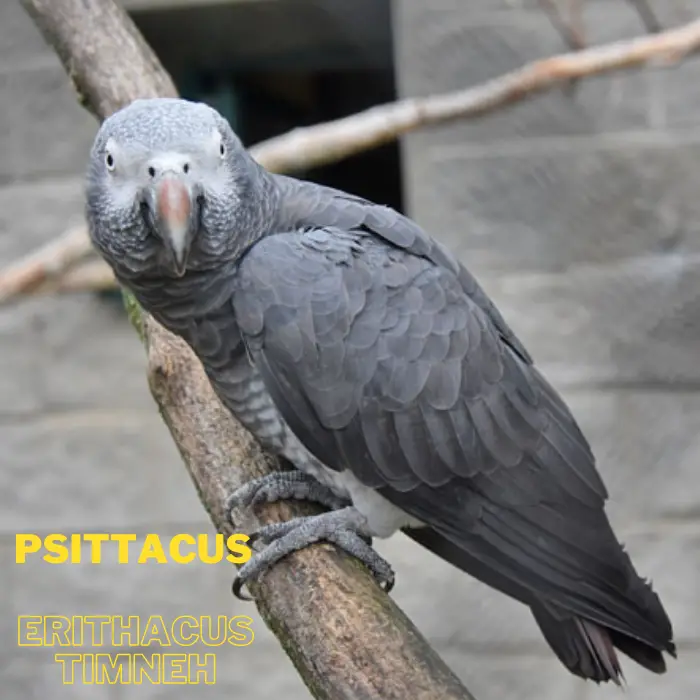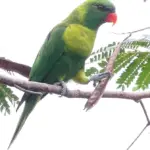
There are 3 recognized species of African Grey bird : Psittacus Erithacus, Psittacus erithacus originators, Psittacus erithacus timneh
African Grey parrot species

Psittacus Erithacus: Commonly known as African Grey Parrot, or Gabonese grey. About 36 cm long, 450-600 grams. Ash-gray plumage, bright red tail. Equatorial Africa.

Psittacus erithacus originators: Also called Ghana Grey, West African Grey bird, or Boyd Alexander. Looks a lot like the Congo, but a little smaller. The Island of Principé and Fernando Po in the Gulf of Guinea.

Psittacus erithacus timneh: African grey Timneh. 23 cm long, 250-350 grams. Plumage dark charcoal gray, brown-red tail. The upper mandible of the pinkish beige beak.
Much smaller than Congo or Ghana. Sierra Leone, Liberia, Guinea, and western Côte d’Ivoire. Temperament is less scowling than Congo or Ghana.
Less fearful and more rebellious. More inclined to do nonsense to attract attention and have fun.
African grey Parrots intelligence
SOURCE:PetraGrey
African Grey parrot talk
The African gray is considered, and rightly so, as being the champion speaker in all categories, of the avian world. It is capable of remarkably reproducing a multitude of sounds, including the human voice.
On the other hand, the gray begins to speak later than the other parrots, around the age of 12 to 18 months. He needs to practice sounds and develop his muscles to properly control the formation of sounds.
The African Gray has no call as such defined for its species ( apart from grunts ). It is therefore not a screaming bird. On the other hand, he can drive the most zen of humans crazy by continuously imitating the ringing of the microwave, the smoke detector, or even, by performing his famous imitation of the backing track!
On the other hand, due to his almost schizoid suspicion, the problem with Talking Gray is that he systematically refuses to perform, ( even when asked politely ), in the presence of strangers ( not immediate family ). . He has the gift of taking refuge in silence to make you pass for the greatest of mythomaniacs!
Since the gray is a suspicious and quite fearful bird, it would be good to provide for its places in height where it will feel safer; trees, ropes, and vines as well as perches hanging from the ceiling. These will be his favorite places to be comfortable in order to give his best vocal performances (speaking, singing).
African grey parrots as pets
Due in large part to its sensitive nature and high intelligence, the African gray parrot can react very negatively to the clumsiness of an educator as well as during the training process.
You should never force a gray to do what he does not want, he could even develop phobic behaviors. Therefore, it is important to teach him early enough that biting is not a way to communicate.
Grays react well only to positive reinforcement. Educating a gray should be more like the education of a child than that of a pet.
The Gray is a very gregarious parrot and he needs to feel accepted and to be a full member of his social group ( human family ). For his balance, both psychic and physiological, he needs a companion of his kind. It’s not a whim… it’s a need.
African Grey parrot Behavior
African Grey Bird forges a very strong bond with his love partner ( bird or human ) and is totally devoted to him. He can also become possessive with the latter and aggressive with those around him.
He can favor his favorite human to the point of excluding all other family members. Here again, good socialization can help prevent this kind of situation.
Due to its wary, shy, and anxious nature, it is not a very sociable bird towards strangers. He will be rather distant, will not be tolerant, unless there are exceptions, with children.
Unfortunately, breeders or dealers tend to only insist on THIS talent for mimicry to sell this bird and this is what makes it so desirable to the buyer. Few people insist on the needs of this intelligent bird, nor on its particular behaviors.
African Grey parrots breeding
SOURCE:wingsNpaws
The gray, more than other parrots, need a calm, safe and peaceful environment. Which does not mean that it is a “cushy” bird… far from it. He can even be very dispirited and curious. He just doesn’t like extravagance, exuberance, and turbulence ( of others ).
The African Gray needs a lot of stimulation in its environment. It is a very curious bird who loves to learn and discover… However, it quickly gets bored of an activity. His mind, always alert, will eagerly seek other stimuli. Up to you…
The African gray is the parrot which, strangely for a bird with such a big inclination for neurosis, has the most stable temperament in the psittacine world. As much as he can be quite turbulent when he is young, at maturity he is calm and thoughtful.
Unlike other parrots, the African grey parrot does not have this inclination to ( so much ) change its personality or behavior during the breeding season, which in my opinion is a very big point in its favor.
African Grey parrot care
Naturally, in order for the bird to have access to heights, it is essential that it can fly. We do not cut the flight feathers of an African grey parrot! Like all stocky parrots (large body, small tail), it needs its feathers to maintain its balance.
In addition, since the first reflex of a bird that is afraid is to fly away, gray needs all its flight feathers more than other parrots. Too many accidents happen to grays who have their flight feathers cut (broken beaks, broken or open breaches, etc.).
The same goes for his nails. Never file them too short. Compared to other parrots of the same size, the African grey bird has smaller feet and thinner fingers. He needs his nails to keep himself in balance on a branch.
African gray parrot can become the best companion in the world, as long as we respect its needs and nature. We do not change an African gray bird, we will say that it adapts to us, and again, only if we deserve it.
It is then up to us to be reliable, not to try to dominate him, and to learn to develop with him a relationship of friendship and respectful cooperation.
African Grey parrot Cage
In order for it to feel safe, gray needs to see everything that is happening around it. For this reason, it is better to install his cage against a wall so that he sees what is happening in front of him without having to constantly monitor his back.
African Grey parrot Health
From a dietary point of view, the African gray parrot has a high need for vitamin A and calcium. As it is prone to hypocalcemia (calcium deficiency) it is important to provide it with foods rich in this mineral.
He also needs a vitamin D3 intake to help him assimilate calcium. In summer, outdoors, the sun will provide him with his daily need for vitamin D3. In winter, the installation of neon lights like Vita-Lite or Verilux Tru-bloom will play the same role.
African Greys Are NOT Cuddly Birds
African Grey Parrot Price
African Parrot Complete Guide
How do I know if my african grey parrot is happy




















